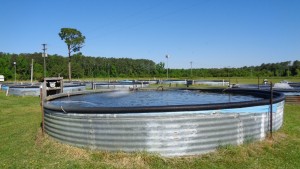Hybrid striped bass are produced on aquaculture farms. The aquaculture systems vary depending on the farm. Hybrid striped bass can be produced in:
- Earthen ponds
- Indoor recirculating aquaculture systems (RASs)
- Cages in existing farm ponds
- Large pens in surface coal mine lakes
Most of the hybrid striped bass produced in aquaculture are the Sunshine Cross (also known as the Reciprocal Cross), which consists of the striped bass male and white bass female. Hormone use is limited to this cross. Human Chorionic Gonadotropin (HCG) hormone is used to induce final maturation and ovulation of the white bass eggs and to enhance sperm production in the male striped bass. HCG is a naturally produced hormone in humans which helps with fertility. Males and females are also anesthetized with MS-222, quinaldine, or clove oil to reduce stress whenever handled. The hormone is injected intramuscularly below the dorsal fin and above the lateral line. White bass females injected with 660 International Units (IU) of HCG per kilogram of body weight to induce ovulation. A sexually mature female white bass will ovulate within 25 to 50 hours after injection depending on water temperature.
Hybrid striped bass production on aquaculture farms has three phases of development:
Phase I:
From fry to one-inch fingerling
Phase II:
Fingerling to six-inch juvenile
Phase III:
Six inch juvenile to market size (about 1.5 pounds)
The costs of production for different aquaculture infrastructures are as follows:
Open Pond Aquaculture
50 acre farm with 10 five water acre ponds – $389,356
2 water-acre farm with a single pond using the direct stocking technology – $72,396
Phase II – Phase III production system using a 50 water-acre farm with 10 five water-acre ponds – $503,648
Direct stocking method production using a 50 water-acre farm with 10 five acre-water ponds – $765,229
Fixed costs of farm with a single 2 water-acre pond, using a cage culture system – $32,739
Variable costs associated with the cage culture using four 128 cubic feet cages in a single 2 water-acre pond – $28,247
Recirculating Aquaculture System
North Carolina State University – $345,000


